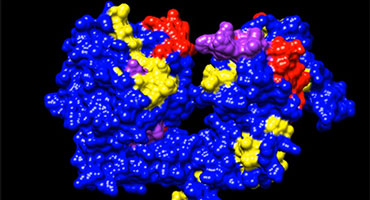Chemical biology
Diagnostics and imaging

Commercial biosensor technology has rapidly taken off over the past decade, with the global biosensors market valued at $18.6 billion in 2018. However, despite the many technological advances in research and development, there are not many biosensors available for routine use outside of hospitals and specialised laboratories. The main technological reasons for that are:
- Poor stability of enzymes and antibodies in practical applications;
- Lack of suitable enzymes for practically important substrates-analytes;
- Lack of an appropriate and generic approach for the transduction of binding event into a detectable electrical signal (particularly in the case of antibody-based sensors).
The research focus of Professor S. A. Piletsky and his team in the Leicester Biotechnology Group (LBG) is molecularly imprinted polymers (MIPs) - the most generic, versatile, scalable and cost-effective form of synthetic molecular receptors, and their application in assays and sensors.1,2,3 Molecular imprinting is the process of template-induced formation of specific recognition sites in a polymer, where a template directs the positioning and orientation of the polymer functional groups by a self-assembling mechanism. MIPs possess a unique combination of properties, such as high affinity, specificity, robustness and low cost of production. Recently we have developed a novel protocol for producing “monoclonal” MIP nanoparticles (nanoMIPs) in the presence of an immobilized analyte, which serves as a template in solid phase synthesis. The important benefits for diagnostic applications lie in the facts that nanoMIPs have affinity and selectivity similar to monoclonal antibodies. They are much more robust than antibodies, do not rely on animals for their production and can be used in assays and sensors without cold chain supply.
The associated translational research surrounding adoption of these materials by diagnostic and pharmaceutical companies has been undertaken in collaboration with leading diagnostic companies and spearheaded by MIP Diagnostics, a spinout company from the University of Leicester.
Selected publications:
- “Detection of Waterborne Viruses Using High Affinity Molecularly Imprinted Polymers”, Z. Altintas, M. Gittens, A. Guerreiro, K.-A. Thompson, J. Walker, S. Piletsky, I. E. Tothill, Anal. Chem., 87, 6801-6807 (2015).
- “Solid-Phase Synthesis of Molecularly Imprinted Nanoparticles”, F. Canfarotta, A. Poma, A. Guerreiro, S. Piletsky, Nat. Protoc., 11, 443-455 (2016).
- “A Novel Capacitive Sensor Based on Molecularly Imprinted Nanoparticles as Recognition Elements”, F. Canfarotta, J. Czulaka, A. Guerreiro, A. G. Cruz, S. Piletsky, G. E. Bergdahl, M. Hedström, B. Mattiasson, Biosens. Bioelectron., 120, 108-114 (2018).
- “Solid‐Phase Synthesis of Molecularly Imprinted Polymer Nanoparticles with a Reusable Template–‘Plastic Antibodies’”, A. Poma, A. Guerreiro, M. J. Whitcombe, E. V. Piletska, A. P. F. Turner, S. A. Piletsky, Adv. Functional. Mater., 23, 2821-2827 (2013).
- “A Comparison of the Performance of Molecularly Imprinted Polymer Nanoparticles for Small Molecule Targets and Antibodies in the ELISA Format”, K. Smolinska-Kempisty, A. Guerreiro, F. Canfarotta, C. Cáceres, M. J. Whitcombe, S. Piletsky, Sci. Rep., 6, 37638 (2016).